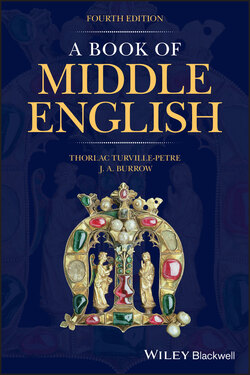Читать книгу A Book of Middle English - J. A. Burrow - Страница 95
8.2 Words and Their Meanings
ОглавлениеA translator, whether from German or Japanese to English, or Middle English to Modern English, must take an important consideration into account: a word in the source language is rarely exactly synonymous with another in the target language. That is to say, the range of associated senses of a word, its semantic field, does not map precisely onto a word in another language. A glossary or concise dictionary may give a different impression. For example, the glossary to this book has the following entry: ‘stout adj. bold 5/184, 293 [OF (e)stout]’. That conveys a certain amount of information in a compressed form: that the adjective stout, which is a borrowing from French, can be translated as ‘bold’ in a couple of instances in Sir Orfeo: Orfeo’s thousand armed knights are ‘stout and grim’, and similarly the fairy knights are ‘Of cuntenaunce stout and fers’. Consultation of comprehensive historical dictionaries that display a word’s semantic field at different periods provides a much richer understanding of stout. From the Oxford English Dictionary we can discover that the earliest records of stout in its common current sense of ‘fat’ date from as late as the nineteenth century, so that sense cannot be relevant to Middle English examples. In its entry for stout(e adj., the Middle English Dictionary divides the senses under six main headings, each subdivided. Some of the applications of the word are positive: (1) ‘bold’ and related senses; (4) ‘noble, splendid’ and similar senses; (5) ‘strong’, of both animate and inanimate objects. But some senses are negative: (2) ‘cruel, violent’; (3) ‘proud, arrogant’. In its printed edition, MED’s entry runs over two pages, quoting a great many examples from the beginning of the fourteenth to the end of the fifteenth century.
If we look again at the two examples of the word in Sir Orfeo in their contexts, we can see that ‘bold’ is not the only translation possible, and that some of the related meanings of stout might be brought into play. In line 184 stout is paired with grim, a word inherited from Old English: citations in MED reveal that grim is used of the Devil ‘grisely and grym’, of dogs and lions, as well as of warriors and battles. So perhaps a translation conveying hostility, such as ‘fierce’, would be more precise in line 184, though the positive senses ‘strong’, even ‘splendidly arrayed for battle’, are also appropriate parts of its semantic range. In line 293 it is the appearance (cuntenaunce) of the fairy knights that is ‘stout and fers’, so that MED cites this instance under 1(c) ‘of the countenance, eyes: reflecting a courageous spirit, bold’, also citing a description of the ‘stout visage’ of Achilles that showed that ‘he was no womman’.
There is a third instance of stout in Sir Orfeo: the fairy castle has a hundred towers that are ‘Degiselich and bataild stout’ (360), translated in our footnote as ‘Wonderful and with strong battlements’. In this case stout is an adverb, and a more literal translation would be ‘strongly fortified with battlements’. Quoting this line, MED glosses ‘richly, splendidly’, which is fair enough, but misses the idea of strength to withstand attack, as recorded in examples of the adjective (5(b)). Any word‐for‐word translation is forced to choose one of a complex of senses, inevitably ignoring others.
The glossary is unable to display the semantic field of a word as a dictionary can do. Furthermore, a selective glossary, as the one in this book, does not record words in their modern senses, so that for example the entry for stronge adj. lists one instance where strong means ‘great’, but not the many other instances where it has its current meaning. To save space, meanings given in the footnotes are not repeated in the glossary.
